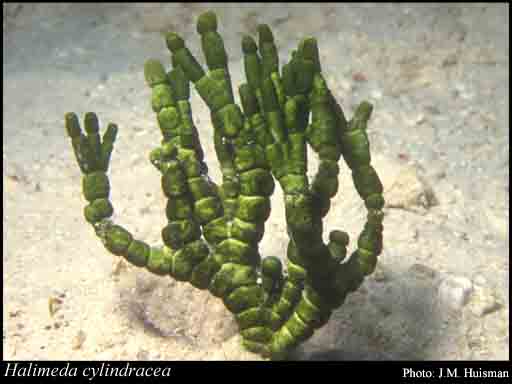- Reference
- Ann.Sci.Nat., Bot. ser. 2, 18:103 (1842)
- Conservation Code
- Not threatened
- Naturalised Status
- Native to Western Australia
- Name Status
- Current







Scientific Description
Habit and structure. Thallus grass-green, erect, to 10 cm tall, excluding the bulbous holdfast consisting of numerous filaments that bind the substratum; exposed part generally dichotomously but sparingly branched; branch segments terete to slightly flattened, sometimes bifurcate; lower segments 3–5 mm diam., 4–6 mm long, tapering gradually to the upper segments 1.0–1.5 mm diam. and 1.5–5.0 mm long. Utricles in 3–5 layers, mostly basally constricted, this more pronounced in peripheral utricles. Peripheral utricles turbinate to pyriform in lateral view, 25–35 µm long and 17–30 μm diam. at the surface, polygonal but occasionally with rounded corners in surface view, remaining firmly attached following decalcification. Medullary siphons 35–90 µm diam., uniting into a horizontal plate at nodes; siphon walls locally thickened.
Distribution. Occurs in the warmer waters of the Indo-Pacific., in W.A. recorded as far south as Coral Bay.
Habitat. Typically grows in unconsolidated substrata.
[After Huisman & Verbruggen, Algae of Australia: Mar. Benthic Algae of North-western Australia, 1. Green and Brown Algae 126 (2015)]
Distribution
- IBRA Regions
- Carnarvon, Dampierland, Northern Kimberley, Pilbara.
- IBRA Subregions
- Cape Range, Mitchell, Pindanland, Roebourne.
- IMCRA Regions
- Canning, Kimberley, Ningaloo, Pilbara (nearshore), Pilbara (offshore).
- Local Government Areas (LGAs)
- Ashburton, Broome, Carnarvon, Exmouth, Karratha, Wyndham-East Kimberley.